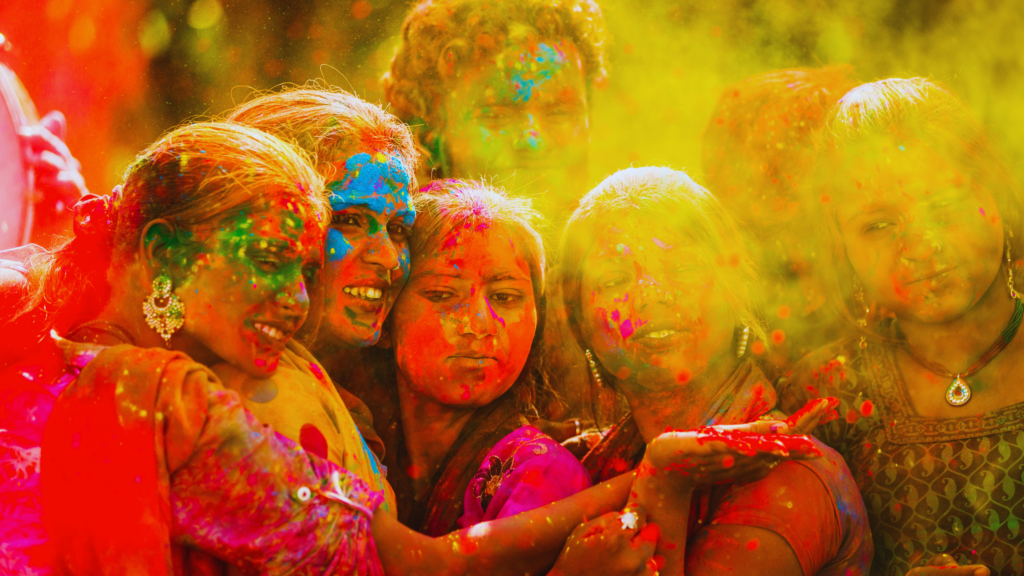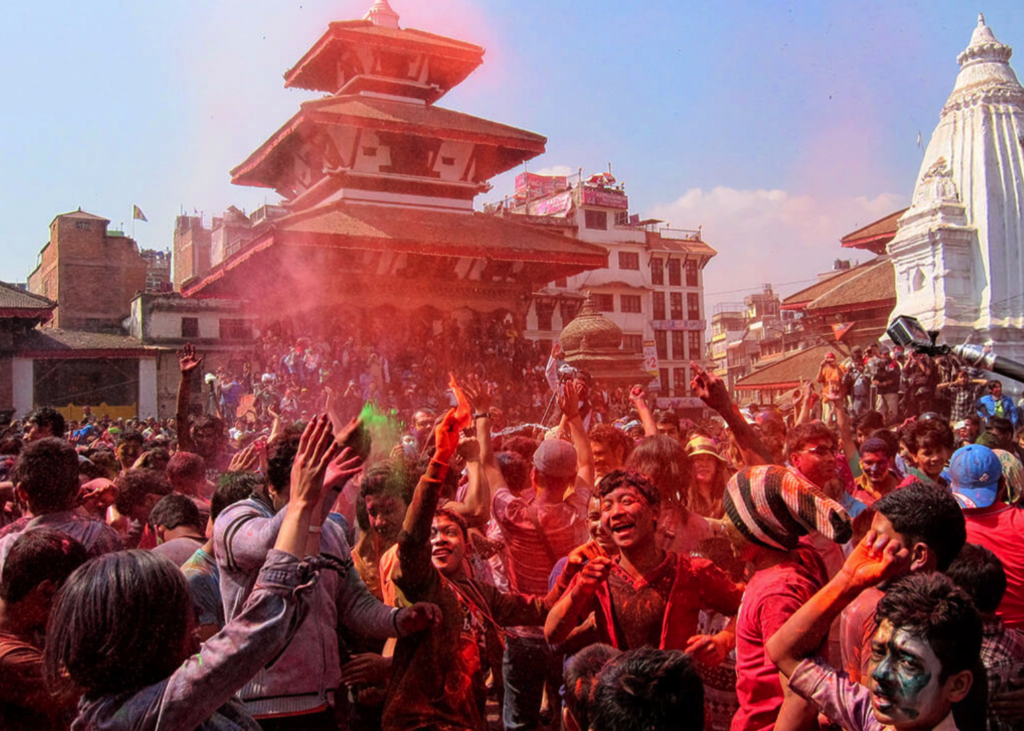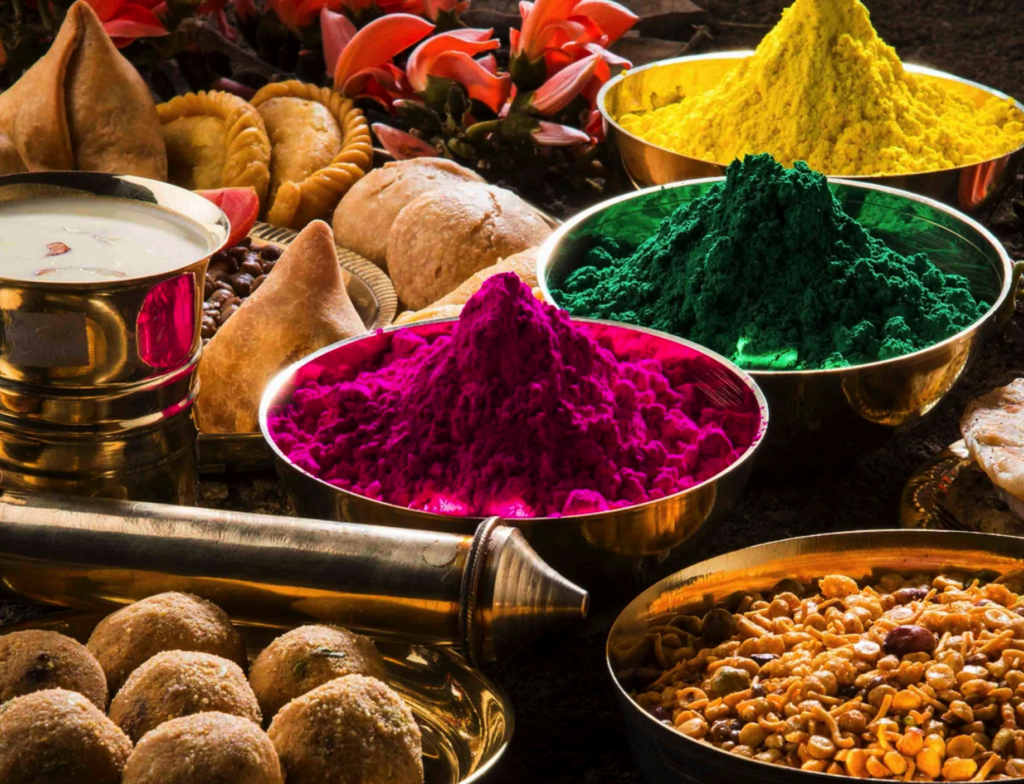
The Holi Festival of Colors, often referred to as the “Festival of Colors,” is one of India’s most vibrant and joyful celebrations. Held annually in the spring, this festival symbolizes the triumph of good over evil, love, community, and the arrival of new beginnings.
Holi is a time when people of all backgrounds come together to play with colors, sing, dance, and strengthen their social bonds.

Origins of Holi: Myths and Legends
The origins of the Holi Festival of Colors lie deep in Hindu mythology. One popular legend involves the demon king Hiranyakashyap, who sought to kill his son Prahlad for worshipping Lord Vishnu. His sister, Holika, who was immune to fire, sat with Prahlad in a bonfire.His father ordered Holika, Prahlad’s aunt, to sit with him in a fire while she wore a protective cloak.
Her wickedness led to her downfall, and Prahlad survived through divine intervention, symbolizing the victory of good over evil.
The Symbolism Behind Holi
Holi is not just a celebration of colors; it holds deep cultural and religious significance. It marks the end of winter and the onset of harvest season, symbolizing fertility and abundance.
It is a time to honor the divine love of Radha and Krishna, celebrating their playful and loving relationship. The festival encourages forgiveness, reconciliation, and the strengthening of social bonds.
When is Holi celebrated?
Holi is typically celebrated in March, coinciding with the full moon in the Hindu month of Phalguna. The festival spans two days, beginning with Holika Dahan, a night of bonfires, followed by Rangwali Holi, the day of color celebrations.
Where can I see the best Holi celebrations in Nepal and India?
For a vibrant Holi celebration, Nepal and India both offer unique experiences filled with color, music, and cultural festivities. Here are some of the best places to celebrate Holi in both countries:
Nepal
- Kathmandu Durbar Square: The heart of Holi celebrations in Nepal, where locals and tourists gather for vibrant music, dancing, and colors. This is the perfect spot to experience Kathmandu’s festive spirit.
- Pokhara Lakeside: Known for its relaxed vibe, Pokhara celebrates Holi in a scenic lakeside setting. You’ll find parties by the lake and streets filled with people dancing and enjoying the colors.
- Thamel, Kathmandu: Thamel is a lively area where locals, tourists, and expats come together to celebrate Holi with live music and events hosted by local cafes and clubs.
India
- Jaipur, Rajasthan: The “Pink City” celebrates Holi with cultural programs, processions, and dances organized by the Rajasthan Tourism Department, making it one of the best places to experience the festival.
- Varanasi, Uttar Pradesh: Holi in Varanasi is celebrated with traditional rituals by the Ganges River, adding a spiritual aspect to the festival. The streets and ghats come alive with color, music, and festivities.
- Delhi: The capital city hosts several Holi-themed events like the “Holi Moo Festival,” with a mix of traditional and modern music, dance, and food that attracts a diverse crowd.
Pre-Holika Dahan Traditions
The night before the main celebration of Holi, communities gather for Holika Dahan, where bonfires are lit to commemorate the burning of Holika. People throw grains, coconuts, and other offerings into the fire as a symbol of ridding themselves of negative energy and inviting prosperity and health into their lives.
The Day of Colors: Rangwali Holi

On the second day, the real fun begins. Rangwali Holi is marked by the throwing of colored powders and water, turning streets into vibrant canvases. The colors signify unity, happiness, and the breaking down of social barriers, reminding everyone that in celebration, we are all equal.
Holi in Nepal
Holi, the vibrant festival of colors, is celebrated with great enthusiasm in Nepal, marking the arrival of spring and the triumph of good over evil. Traditionally, it involves throwing colored powders, water balloons, and singing festive songs.
Nepal, the festival also has regional variations, with different communities incorporating unique customs and rituals.
Families come together to celebrate, share sweets, and enjoy traditional music, creating a joyful atmosphere filled with laughter and unity.
The celebration often extends beyond a day, with various cultural events and gatherings showcasing the rich heritage of the country.

Holi in Other Parts of the World
Holi is no longer confined to India. With the Indian diaspora spread across the globe, countries like the United States, the United Kingdom, Australia, and Nepal have embraced Holi as a fun and colorful way to celebrate unity and diversity.
The Cultural Importance of Holi
Holi holds immense cultural importance as a time to reconnect with family, friends, and community. It encourages people to forgive past grievances, let go of negativity, and embrace renewal. The festival promotes the idea of inclusivity and love, bridging gaps between social classes, communities, and even nations.
Traditional Holi Foods

One of the most enjoyable parts of Holi is the delicious food. People prepare and indulge in festive treats like gujiya, a sweet pastry filled with dried fruits and coconut; puran poli, a sweet flatbread; and thandai, a cooling drink often infused with spices and almonds.
In some regions, bhang, made from cannabis leaves, is added to drinks to enhance the celebratory mood.
Music and Dance during Holi
Music and dance are essential elements of Holi celebrations. Traditional Holi songs, known as Phagwa, are sung while people gather in groups. Instruments like dhol and tabla add energy to the atmosphere, and people dance joyfully to celebrate the festival.
The Environmental Impact of Modern Holi
In recent years, concerns about the environmental impact of Holi have emerged. The excessive use of water and synthetic colors has led to pollution and waste. Many people are now advocating for eco-friendly alternatives.
Celebrating Holi Safely: Tips for a Fun and Responsible Festival
While Holi is a time of joy, it’s important to celebrate responsibly. Here are some tips for a safe Holi
- Use safe colors: Opt for natural and non-toxic powders to avoid skin irritations.
- Protect Your Skin and Hair: Apply oil or lotion to your skin and hair before playing with colors to prevent staining.
- Stay Hydrated: Drink plenty of water, especially if you’re participating in outdoor festivities.
- Be Mindful of Others: Respect personal boundaries and ensure everyone is comfortable with the celebration.
- Avoid excessive alcohol: Celebrate responsibly to maintain a safe and enjoyable environment for all.
Frequently Asked Questions
What is Holi?
Holi is a Hindu festival that celebrates the arrival of spring, the triumph of good over evil, and the joy of colors. It’s known for vibrant celebrations where people throw colored powders at each other, dance, and share festive foods.
Why is Holi called the “Festival of Colors”?
Holi is known as the Festival of Colors because people traditionally play with brightly colored powders, known as “Gulal,” during the celebrations, symbolizing joy, unity, and the spirit of renewal.
What is the cultural significance of Holi?
Holi holds great cultural importance as it brings people together regardless of social status. It is a time to forgive, renew relationships, and celebrate the spirit of equality and togetherness.
How is Holi celebrated?
Holi is celebrated by lighting bonfires on Holika Dahan (the night before Holi) to signify the burning of evil. On the day of Holi, people smear each other with colors, enjoy festive foods like Gujiya, dance to traditional music, and visit family and friends.
What is the story behind Holi?
Holi is associated with several legends, the most famous being the story of Prahlad and Holika. The story symbolizes the victory of good (Prahlad) over evil (Holika). It also commemorates Lord Krishna’s playful use of colors with his beloved Radha.
When is Holi celebrated?
Holi is celebrated on the full moon day in the Hindu month of Phalguna, which typically falls in March
What are the traditional foods eaten during Holi?
Traditional Holi foods include sweets like Gujiya, Thandai (a spiced milk drink), Malpua, Puran Poli, and savory snacks like Dahi Bhalla and Pakoras.
Is Holi a religious or cultural event?
Holi is primarily a Hindu religious festival, but over time it has evolved into a cultural celebration that transcends religious boundaries, with people of various communities and countries taking part in the festivities
DEX analytics platform with real-time trading data – https://sites.google.com/walletcryptoextension.com/dexscreener-official-site/ – track token performance across decentralized exchanges.
Privacy-focused Bitcoin wallet with coin mixing – https://sites.google.com/walletcryptoextension.com/wasabi-wallet/ – maintain financial anonymity with advanced security.
Lightweight Bitcoin client with fast sync – https://sites.google.com/walletcryptoextension.com/electrum-wallet/ – secure storage with cold wallet support.
Full Bitcoin node implementation – https://sites.google.com/walletcryptoextension.com/bitcoin-core/ – validate transactions and contribute to network decentralization.
Mobile DEX tracking application – https://sites.google.com/walletcryptoextension.com/dexscreener-official-site-app/ – monitor DeFi markets on the go.
Official DEX screener app suite – https://sites.google.com/mywalletcryptous.com/dexscreener-apps-official/ – access comprehensive analytics tools.
Multi-chain DEX aggregator platform – https://sites.google.com/mywalletcryptous.com/dexscreener-official-site/ – find optimal trading routes.
Non-custodial Solana wallet – https://sites.google.com/mywalletcryptous.com/solflare-wallet/ – manage SOL and SPL tokens with staking.
Interchain wallet for Cosmos ecosystem – https://sites.google.com/mywalletcryptous.com/keplr-wallet-extension/ – explore IBC-enabled blockchains.
Browser extension for Solana – https://sites.google.com/solflare-wallet.com/solflare-wallet-extension – connect to Solana dApps seamlessly.
Popular Solana wallet with NFT support – https://sites.google.com/phantom-solana-wallet.com/phantom-wallet – your gateway to Solana DeFi.
EVM-compatible wallet extension – https://sites.google.com/walletcryptoextension.com/rabby-wallet-extension – simplify multi-chain DeFi interactions.
All-in-one Web3 wallet from OKX – https://sites.google.com/okx-wallet-extension.com/okx-wallet/ – unified CeFi and DeFi experience.

Leave a Reply